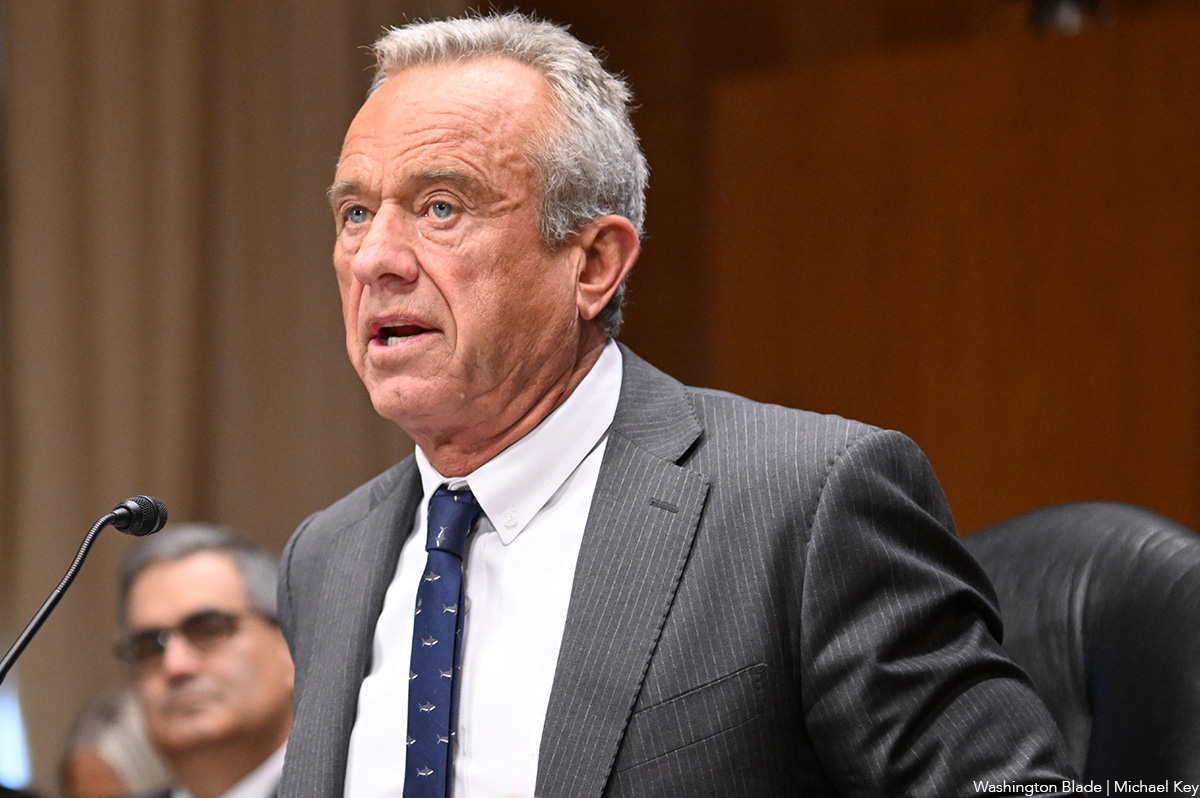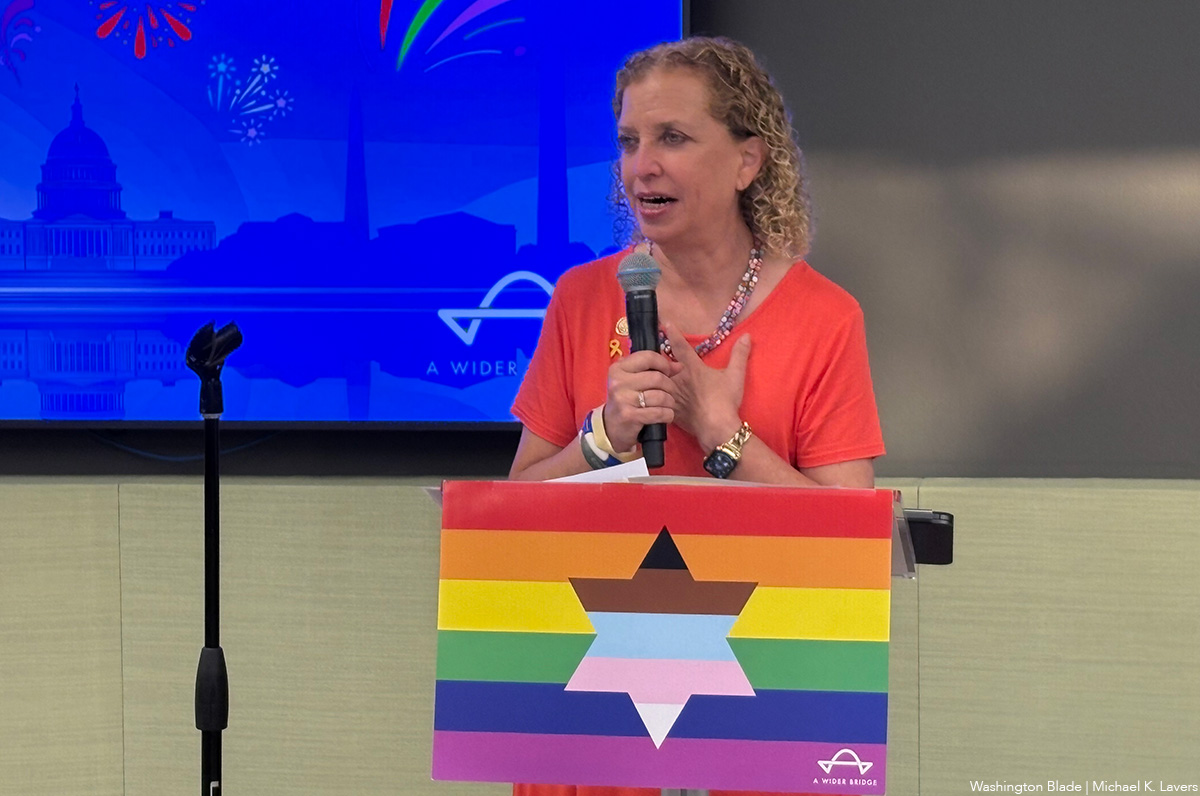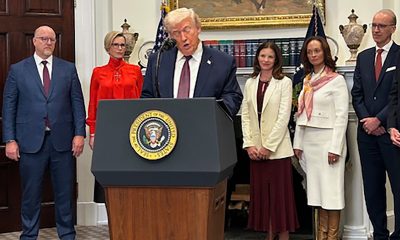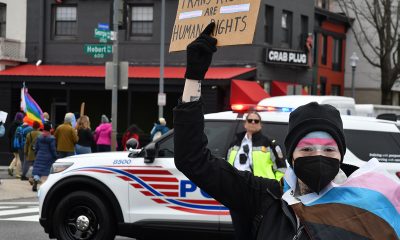National
Medical groups file lawsuit over Trump deletion of health information
Crucial datasets included LGBTQ, HIV resources

Nine private medical and public health advocacy organizations, including two from D.C., filed a lawsuit on May 20 in federal court in Seattle challenging what it calls the U.S. Department of Health and Human Services’s illegal deletion of dozens or more of its webpages containing health related information, including HIV information.
The lawsuit, filed in the United States District Court for the Western District of Washington, names as defendants Robert F. Kennedy Jr., secretary of the Department of Health and Human Services (HHS) and HHS itself, and several agencies operating under HHS and its directors, including the Centers for Disease Control and Prevention, the National Institutes of Health, and the Food and Drug Administration.
“This action challenges the widespread deletion of public health resources from federal agencies,” the lawsuit states. “Dozens (if not more) of taxpayer-funded webpages, databases, and other crucial resources have vanished since January 20, 2025, leaving doctors, nurses, researchers, and the public scrambling for information,” it says.
“These actions have undermined the longstanding, congressionally mandated regime; irreparably harmed Plaintiffs and others who rely on these federal resources; and put the nation’s public health infrastructure in unnecessary jeopardy,” the lawsuit continues.
It adds, “The removal of public health resources was apparently prompted by two recent executive orders – one focused on ‘gender ideology’ and the other targeting diversity, equity, and inclusion (‘DEI’) programs. Defendants implemented these executive orders in a haphazard manner that resulted in the deletion (inadvertent or otherwise) of health-related websites and databases, including information related to pregnancy risks, public health datasets, information about opioid-use disorder, and many other valuable resources.”
The lawsuit does not mention that it was President Donald Trump who issued the two executive orders in question.
A White House spokesperson couldn’t immediately be reached for comment on the lawsuit.
While not mentioning Trump by name, the lawsuit names as defendants in addition to HHS Secretary Robert Kennedy Jr., Matthew Buzzelli, acting director of the Centers for Disease Control and Prevention; Jay Bhattacharya, director of the National Institutes of Health; Martin Makary, commissioner of the Food and Drug Administration; Thomas Engels, administrator of the Health Resources and Services Administration; and Charles Ezell, acting director of the Office of Personnel Management.
The 44-page lawsuit complaint includes an addendum with a chart showing the titles or descriptions of 49 “affected resource” website pages that it says were deleted because of the executive orders. The chart shows that just four of the sites were restored after initially being deleted.
Of the 49 sites, 15 addressed LGBTQ-related health issues and six others addressed HIV issues, according to the chart.
“The unannounced and unprecedented deletion of these federal webpages and datasets came as a shock to the medical and scientific communities, which had come to rely on them to monitor and respond to disease outbreaks, assist physicians and other clinicians in daily care, and inform the public about a wide range of healthcare issues,” the lawsuit states.
“Health professionals, nonprofit organizations, and state and local authorities used the websites and datasets daily in care for their patients, to provide resources to their communities, and promote public health,” it says.
Jose Zuniga, president and CEO of the International Association of Providers of AIDS Care (IAPAC), one of the organizations that signed on as a plaintiff in the lawsuit, said in a statement that the deleted information from the HHS websites “includes essential information about LGBTQ+ health, gender and reproductive rights, clinical trial data, Mpox and other vaccine guidance and HIV prevention resources.”
Zuniga added, “IAPAC champions evidence-based, data-informed HIV responses and we reject ideologically driven efforts that undermine public health and erase marginalized communities.”
Lisa Amore, a spokesperson for Whitman-Walker Health, D.C.’s largest LGBTQ supportive health services provider, also expressed concern about the potential impact of the HHS website deletions.
“As the region’s leader in HIV care and prevention, Whitman-Walker Health relies on scientific data to help us drive our resources and measure our successes,” Amore said in response to a request for comment from the Washington Blade.
“The District of Columbia has made great strides in the fight against HIV,” Amore said. “But the removal of public facing information from the HHS website makes our collective work much harder and will set HIV care and prevention backward,” she said.
The lawsuit calls on the court to issue a declaratory judgement that the “deletion of public health webpages and resources is unlawful and invalid” and to issue a preliminary or permanent injunction ordering government officials named as defendants in the lawsuit “to restore the public health webpages and resources that have been deleted and to maintain their web domains in accordance with their statutory duties.”
It also calls on the court to require defendant government officials to “file a status report with the Court within twenty-four hours of entry of a preliminary injunction, and at regular intervals, thereafter, confirming compliance with these orders.”
The health organizations that joined the lawsuit as plaintiffs include the Washington State Medical Association, Washington State Nurses Association, Washington Chapter of the American Academy of Pediatrics, Academy Health, Association of Nurses in AIDS Care, Fast-Track Cities Institute, International Association of Providers of AIDS Care, National LGBT Cancer Network, and Vermont Medical Society.
The Fast-Track Cities Institute and International Association of Providers of AIDS Care are based in D.C.

A Wider Bridge on Friday announced it will shut down at the end of the month.
The group that “mobilizes the LGBTQ community to fight antisemitism and support Israel and its LGBTQ community” in a letter to supporters said financial challenges prompted the decision.
“After 15 years of building bridges between LGBTQ communities in North America and Israel, A Wider Bridge has made the difficult decision to wind down operations as of Dec. 31, 2025,” it reads.
“This decision comes after challenging financial realities despite our best efforts to secure sustainable funding. We deeply appreciate our supporters and partners who made this work possible.”
Arthur Slepian founded A Wider Bridge in 2010.
The organization in 2016 organized a reception at the National LGBTQ Task Force’s Creating Change Conference in Chicago that was to have featured to Israeli activists. More than 200 people who protested against A Wider Bridge forced the event’s cancellation.
A Wider Bridge in 2024 urged the Capital Pride Alliance and other Pride organizers to ensure Jewish people can safely participate in their events in response to an increase in antisemitic attacks after Hamas militants attacked Israel on Oct. 7, 2023.
The Jewish Telegraphic Agency reported authorities in Vermont late last year charged Ethan Felson, who was A Wider Bridge’s then-executive director, with lewd and lascivious conduct after alleged sexual misconduct against a museum employee. Rabbi Denise Eger succeeded Felson as A Wider Bridge’s interim executive director.
A Wider Bridge in June honored U.S. Rep. Debbie Wasserman Schultz (D-Fla.) at its Pride event that took place at the Capital Jewish Museum in D.C. The event took place 15 days after a gunman killed two Israeli Embassy employees — Yaron Lischinsky and Sarah Milgrim — as they were leaving an event at the museum.
“Though we are winding down, this is not a time to back down. We recognize the deep importance of our mission and work amid attacks on Jewish people and LGBTQ people – and LGBTQ Jews at the intersection,” said A Wider Bridge in its letter. “Our board members remain committed to showing up in their individual capacities to represent queer Jews across diverse spaces — and we know our partners and supporters will continue to do the same.”
Editor’s note: Washington Blade International News Editor Michael K. Lavers traveled to Israel and Palestine with A Wider Bridge in 2016.
The White House
‘Trump Rx’ plan includes sharp cuts to HIV drug prices
President made announcement on Friday

President Donald Trump met with leaders from some of the world’s largest pharmaceutical companies at the White House on Friday to announce his new “Trump Rx” plan and outline efforts to reduce medication costs for Americans.
During the roughly 47-minute meeting in the Roosevelt Room, Trump detailed his administration’s efforts to cut prescription drug prices and make medications more affordable for U.S. patients.
“Starting next year, American drug prices will come down fast, furious, and will soon be among the lowest in the developed world,” Trump said during the meeting. “For decades, Americans have been forced to pay the highest prices in the world for prescription drugs by far … We will get the lowest price of anyone in the world.”
Trump signed an executive order in May directing his administration “to do everything in its power to slash prescription drug prices for Americans while getting other countries to pay more.”
“This represents the greatest victory for patient affordability in the history of American health care, by far, and every single American will benefit,” he added.
Several pharmaceutical executives stood behind the president during the announcement, including Sanofi CEO Paul Hudson, Novartis CEO Vas Narasimhan, Genentech CEO Ashley Magargee, Boehringer Ingelheim (USA) CEO Jean-Michel Boers, Gilead Sciences CEO Dan O’Day, Bristol Myers Squibb General Counsel Cari Gallman, GSK CEO Emma Walmsley, Merck CEO Robert Davis, and Amgen Executive Vice President Peter Griffith.
Also in attendance were Health and Human Services Secretary Robert F. Kennedy Jr., Commerce Secretary Howard Lutnick, Centers for Medicare and Medicaid Services Administrator Mehmet Oz, and Food and Drug Administration Commissioner Marty Makary.
Under the Trump Rx plan, the administration outlined a series of proposed drug price changes across multiple companies and therapeutic areas. Among them were reductions for Amgen’s cholesterol-lowering drug repatha from $573 to $239; Bristol Myers Squibb’s HIV medication reyataz from $1,449 to $217; Boehringer Ingelheim’s type 2 diabetes medication jentadueto from $525 to $55; Genentech’s flu medication xofluza from $168 to $50; and Gilead Sciences’ hepatitis C medication epclusa from $24,920 to $2,425.
Additional reductions included several GSK inhalers — such as the asthma inhaler advair diskus 500/50, from $265 to $89 — Merck’s diabetes medication januvia from $330 to $100, Novartis’ multiple sclerosis medication mayzent from $9,987 to $1,137, and Sanofi’s blood thinner plavix from $756 to $16. Sanofi insulin products would also be capped at $35 per month’s supply.
These prices, however, would only be available to patients who purchase medications directly through TrumpRx. According to the program’s website, TrumpRx “connects patients directly with the best prices, increasing transparency, and cutting out costly third-party markups.”
Kennedy spoke after Trump, thanking the president for efforts to lower pharmaceutical costs in the U.S., where evidence has shown that drug prices — including both brand-name and generic medications — are nearly 2.78 times higher than prices in comparable countries. According to the Pharmaceutical Research and Manufacturers of America, roughly half of every dollar spent on brand-name drugs goes to entities that play no role in their research, development, or manufacturing.
“This is affordability in action,” Kennedy said. “We are reversing that trend and making sure that Americans can afford to get the life-saving solutions.”
Gilead CEO Dan O’Day also spoke about how the restructuring of drug costs under TrumpRx, combined with emerging technologies, could help reduce HIV transmission — a virus that, if untreated, can progress to AIDS. The LGBTQ community remains disproportionately affected by HIV.
“Thank you, Mr. President — you and the administration,” O’Day said. “I think this objective of achieving the commitment to affordability and future innovation is extraordinary … We just recently launched a new medicine that’s only given twice a year to prevent HIV, and we’re working with Secretary Kennedy and his entire team, as well as the State Department, as a part of your strategy to support ending the epidemic during your term.
“I’ve never been more optimistic about the innovation that exists across these companies and the impact this could have on America’s health and economy,” he added.
Trump interjected, asking, “And that’s working well with HIV?”
“Yes,” O’Day replied.
“It’s a big event,” Trump said.
“It literally prevents HIV almost 100 percent given twice a year,” O’Day responded.
A similar anti-HIV medication is currently prescribed more than injectable form mentioned by O’Day. PrEP, is a medication regimen proven to significantly reduce HIV infection rates for people at high risk. Without insurance, brand-name Truvada can cost roughly $2,000 per month, while a generic version costs about $60 per month.
Even when medication prices are reduced, PrEP access carries additional costs, including clinic and laboratory fees, office visits, required HIV and sexually transmitted infection testing, adherence services and counseling, and outreach to potentially eligible patients and providers.
According to a 2022 study, the annual total cost per person for PrEP — including medication and required clinical and laboratory monitoring — is approximately $12,000 to $13,000 per year.
The TrumpRx federal platform website is now live at TrumpRx.gov, but the program is not slated to begin offering reduced drug prices until January.
The White House
EXCLUSIVE: Democracy Forward files FOIA lawsuit after HHS deadnames Rachel Levine
Trans former assistant health secretary’s name changed on official portrait

Democracy Forward, a national legal organization that works to advance democracy and social progress through litigation, policy and public education, and regulatory engagement, filed a lawsuit Friday in federal court seeking to compel the U.S. Department of Health and Human Services to release information related to the alteration of former Assistant Secretary for Health Adm. Rachel Levine’s official portrait caption.
The lawsuit comes in response to the slow pace of HHS’s handling of multiple Freedom of Information Act requests — requests that federal law requires agencies to respond to within 20 working days. While responses can take longer due to backlogs, high request volumes, or the need for extensive searches or consultations, Democracy Forward says HHS has failed to provide any substantive response.
Democracy Forward’s four unanswered FOIA requests, and the subsequent lawsuit against HHS, come days after someone in the Trump-Vance administration changed Levine’s official portrait in the Hubert H. Humphrey Building to display her deadname — the name she used before transitioning and has not used since 2011.
According to Democracy Forward, HHS “refused to release any records related to its morally wrong and offensive effort to alter former Assistant Secretary for Health Admiral Rachel Levine’s official portrait caption.” Levine was the highest-ranking openly transgender government official in U.S. history and served as assistant secretary for health and as an admiral in the U.S. Public Health Service Commissioned Corps from 2021 to 2025.
Democracy Forward President Skye Perryman spoke about the need to hold the Trump-Vance administration accountable for every official action, especially those that harm some of the most targeted Americans, including trans people.
“The question every American should be asking remains: what is the Trump-Vance administration hiding? For an administration that touts its anti-transgender animus and behavior so publicly, its stonewalling and silence when it comes to the people’s right to see public records about who was behind this decision is deafening,” Perryman said.
“The government’s obligation of transparency doesn’t disappear because the information sought relates to a trailblazing former federal official who is transgender. It’s not complicated — the public is entitled to know who is making decisions — especially decisions that seek to alter facts and reality, erase the identity of a person, and affect the nation’s commitment to civil rights and human dignity.”
“HHS’s refusal to respond to these lawful requests raises more serious concerns about transparency and accountability,” Perryman added. “The public has every right to demand answers — to know who is behind this hateful act — and we are going to court to get them.”
The lawsuit also raises questions about whether the alteration violated federal accuracy and privacy requirements governing Levine’s name, and whether the agency improperly classified the change as an “excepted activity” during a lapse in appropriations. By failing to make any determination or produce any records, Democracy Forward argues, HHS has violated its obligations under federal law.
The case, Democracy Forward Foundation v. U.S. Department of Health and Human Services, was filed in the U.S. District Court for the District of Columbia. The legal team includes Anisha Hindocha, Daniel McGrath, and Robin Thurston.
The Washington Blade reached out to HHS, but has not received any comment.
The lawsuit and four FOIA requests are below:
-

 Politics2 days ago
Politics2 days agoLGBTQ Democrats say they’re ready to fight to win in 2026
-

 District of Columbia2 days ago
District of Columbia2 days agoBrian Footer suspends campaign for Ward 1 D.C. Council seat
-

 Chile5 days ago
Chile5 days agoFar-right José Antonio Kast elected Chile’s next president
-

 Opinions3 days ago
Opinions3 days agoLighting candles in a time of exhaustion



















